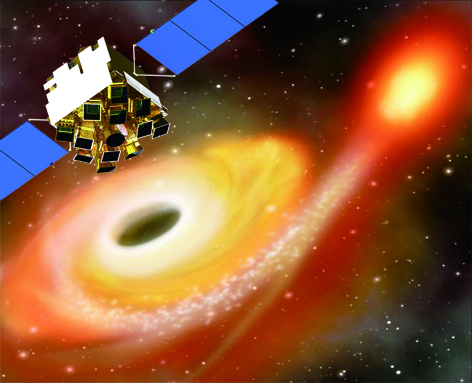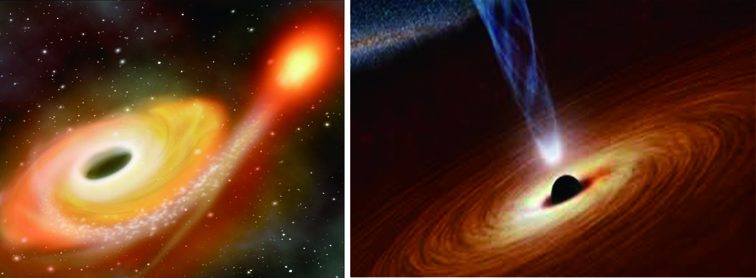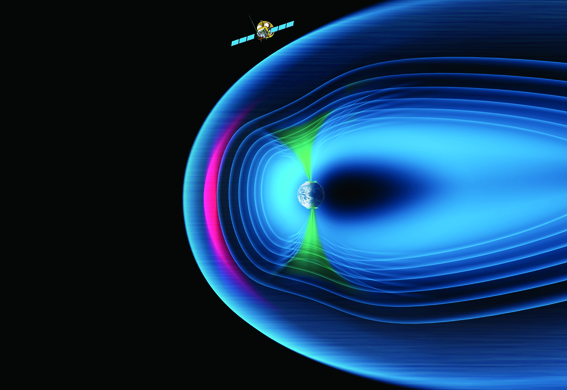By SONG Jianlan (Staff Reporter)

Following its successful efforts to send and operate four satellites for science research, the Chinese Academy of Sciences (CAS) unveiled on July 4th four more space missions, in quest for secrets of the cosmos and the solar system, from which we have come and, on which we have lived.
CAS sent four satellites into space during the five years from 2011 to 2016 (exactly during the period of the 12th national five-year plan of China), including the “Micius” for quantum science experiments and the Dark Matter Particle Explorer (DAMPE). Now four more are coming, as revealed at a small ceremony in suburban Beijing on July 14.
Grand Plan
This time, under the Phase-II of the CAS-sponsored Strategic Priority Program on Space Science (SPPSS-II), CAS unveiled a new wave of space missions for science research, in a hierarchical array: On the frontier are four satellites to be sent into orbit around 2022, and meanwhile endorsed are a pool of projects at different phases of research, verification and consideration, including three proposed missions adopted under the “major background study category,” and a series of projects at stages of concept study and pre-phase A study. In addition, projects for mission planning and data analysis are also included in the program.
Under this grand program, said Prof. WANG Chi, Director of the National Space Science Centre (NSSC) and steersman of the whole SPPSS-II, four satellites will be launched around 2022, including the Einstein Probe (EP), a mission aimed at detecting transients in the X-ray universe; the Advanced Space-based Solar Observatory (ASO-S), a space-based astronomical observatory for solar physics; the Solar wind Magnetosphere Ionosphere Link Explorer (SMILE), a joint project with the European Space Agency focusing on the interaction between the solar wind and the Earth’s magnetosphere; and the Gravitational wave high-energy Electromagnetic Counterpart All-sky Monitor (GECAM), a mission to search for high-energy electromagnetic counterparts of gravitational wave events.
WANG meanwhile works as the Principal Investigator of SMILE and Deputy Commander-in-Chief for both SMILE and ASO-S.
Highlighted among the four missions, EP, ASO-S and SMILE have already formally kicked off and proceed to engineering development. The latecomer GECAM, however, will be sent into the orbit in 2020, after a relatively short period of research, verification and consideration.

Left: Imaginary scene of a tidal disruption event – A black hole is depicted preying on a star.
Right: Illustrated is the mass of a prey star falling on a black hole and a relativistic jet produced as a consequence. (Images: NASA)
Einstein Probe: Revealing the “Violent” Side of the Cosmos
Working within a soft X-ray band ranging from 0.5 to 4 keV, EP aims to perform a sensitive, high-resolution survey in real time of transients and other variable objects – prominent cosmic events that change drastically over time. Scheduled to launch around the end of 2022 and to keep working for three to five years thereafter, the mission promises to detect dazzling flares from otherwise quiescent black holes, pick up the X-ray signals from the sources of gravitational waves, and identify other objects that give off ever-changing X-ray signals, including supernova shock breakouts, high-redshift gamma-ray bursts, and even alternative candidates of dark matter.
Falling within EP’s wide spectrum of targets is a type of rarely detected objects called tidal disruption events (TDEs), predatory scenarios occurring on the brim of black holes. In such cases, the mass of a star – which unfortunately staggers in the gravitational territory of a black hole nearby, gets swallowed by the formidable predator. If one could see via X-rays, which falls far short of the spectrum of visible light, he or she would behold a spectacular scene, in which the flares from the burning prey keep shining in variable, ever-changing nuances of color – just as what an artist might illustrate in imagination.
These predatory events, however cruel might they be, offer a great opportunity to peer in black holes. At the very least, the lethal flares are “visible” for X-ray detectors, otherwise the latent predators would stay silent and invisible, transmitting very little radiation – hardly can any electromagnetic waves escape their mighty gravitational field.
“TDEs are a unique probe of quiescent, hidden black holes, the vast majority of the black hole population postulated to be pervading the universe,” said Dr. YUAN Weimin, researcher from the National Astronomical Observatories of China (NAOC), CAS and Principal Investigator of EP. Once put into operation, he continued, the team expected that EP might discover tens to a hundred TDEs in just a single year, a sharp rise compared with what humankind has so far detected altogether – a mere collection of about two dozen.
Data from EP concerning TDEs might help scientists answer some open questions, including the prevalence, origin and evolution of black holes; how mass falls into them; and how jet-flows are launched. Black holes are known as “singularities” in the cosmos, in which extreme conditions prevail and long-standing enigmas take their own lives. They might give clues about the brim of time and space. Who knows how they will surprise us?
Another type of major targets in EP’s scope are X-ray signals associated with gravitational wave sources, which indicate the occurrences of grand events in the cosmos, such as the merging of black holes or neutron stars, or a hybrid pair that combines the two.
The identification of the first (and the only so far) verified electromagnetic counterpart of gravitational wave source, the signal from the merging of a pair of neutron stars on Aug 17, 2017, has raised the aspirations of astronomers for further explorations into astrophysics. Urged by this thirst, astronomers all over the world have hit the ground running to detect more such counterparts, hailing the dawn of an era of multi-messenger astronomy.
“It means a lot to detect more electromagnetic counterparts of gravitational waves,” YUAN explained. “With more cases of such we might be able to unravel the physical laws underlying such cosmic impacts and their aftermath, and even help solve some open questions in cosmology.”
YUAN expected that EP might be able to detect a few of such astronomical events, working with gravitational wave detectors like LIGO, VIRGO and other future devices to come, though he admitted and allowed quite some uncertainty in the future observations. After all, very little is known so far in this field.
“The detection of the first gravitational waves marks the beginning, rather than the end, of a new cosmic era,” YUAN asserted when asked about why EP was set to detect more of such events. “Actually, what’s the most important for scientists is not to triumph in awards or competition,” he added, “but to explore into the unknown.”
According to YUAN, the reason why this mission was named after Albert Einstein is exactly because both its two major targets, namely black holes and gravitational waves, lock onto theories formulated by this distinguished physicist.
Surveying such events that drastically evolving over time – astrophysicists call them “transients” – is like shooting a movie of the cosmos, said YUAN. This movie captures numerous transversal profiles of cosmic events at different evolutional phases, and might help scientists reconstruct how the corresponding celestial objects evolve.
The target objects of EP occur sporadically at random, and this makes necessary its extraordinarily wide field of view – endowed by a state-of-the-art X-ray imaging technology called lobster-eye micro-pore optics1, which was inspired by the unusual imaging principle of lobster eyes. Moreover, it offers the best sensitivity and spatial resolution so far for similar purposes. Compared with current similar facilities like Swift and MAXI, it covers an observational scope bigger by two to three orders of magnitude.
Working in an X-ray band complementary with other current equipment and with an unprecedentedly high resolution, it is capable of detecting objects much darker and farther away than ever – this means it can pick up signals from a much earlier share of the cosmos.
In synergy with other observational facilities around the world, YUAN noted, EP will provide data of high quality for future astronomical research of humankind, in quest for many important questions, including the birth, evolution and death of the first stars.
“The past evolution of astronomy indicates,” YUAN explained, “every time when the observational capability improved by one order of magnitude, the discipline saw a growth by leaps and bounds. Sometimes, disciplinary revolution could follow.”
“The Einstein Probe,” he continued, “is dedicated to astronomical discoveries of the future.”

Illustration of ASO-S, the first Chinese solar mission to be launched in 2022. (Image by ASO-S Team)
ASO-S: Understanding Our Relationship with the Sun
The Advanced Space-based Solar Observatory (ASO-S) marks the first satellite of China specially designed and built for space-based solar observation. It is dedicated to revealing the formative mechanisms and mutual interplays of the solar magnetic (M) field and the two major eruptive phenomena (bursts) of the Sun, namely the solar flares and coronal mass ejections (CMEs), which are not fully understood by scientists to date. Its objectives are hence summarized as “1M2B” by the team.
Proposed by the Chinese solar community in 2011 and approved as a verified project under SPPSS-II in June 2017, the ASO-S mission will fly in early 2022 and stay in orbit for at least 4 years. The satellite is designed to carry three payloads: the Full-disk solar vector MagnetoGraph (FMG), the Lyman-alpha Solar Telescope (LST), and the solar Hard X-ray Imager (HXI), respectively aimed at measuring the solar magnetic field, and observing CMEs and solar flares.
According to Prof. GAN Weiqun, researcher from the Purple Mountain Observatory (PMO), CAS and Principal Investigator of ASO-S, the unique combination of these payloads will allow for the first time at a single platform simultaneous observations of the vector magnetic field of the full Sun, non-thermal images of solar flares, and initiation and early propagation of CMEs in Lyman-alpha line.
So far, the triggering and driving mechanisms of solar flares and CMEs are still elusive and hence remain attractive topics for the international solar physical community. In principle, scientists agree that the flares could be a local phenomenon; while CMEs are more complicated – they could be of either local or global origin. In addition, the connection between solar flares and CMEs is still unclear. “Observations of the source areas on the solar surface could be of vital importance for understanding the whole physical process,” emphasized GAN.
Currently, solar physicists tend to believe that solar flares and CMEs mainly gain their momentum from the solar magnetic field; or more precisely, they draw energy from the non-potential energies of the solar magnetic field. That said, what kind of evolution in the magnetic field could drive the flares and CMEs to burst out? This remains a question of great importance and, glamour.
Also, ASO-S seeks to understand how the solar atmosphere responds to solar bursts at different atmospheric levels, and to further reveal the underlying energy transport mechanisms and dynamic properties of solar bursts. The observation of ASO-S can help establish an energy transport mechanism for solar bursts amid the solar atmosphere, noted GAN. Analysis of this energy transport plays a key role in understanding how energy is distributed and later released by flares and CMEs, and is helpful for understanding the properties of energetic particles that escape into the near-Earth space during the bursts. And this, is relevant to the daily lives of human beings.
ASO-S will not only advance our understanding of the underlying physics of solar eruptions, but also help improve our forecast capability for space weathers. For example, in principle we might be able to forecast the occurrence of solar energetic particle events minutes or dozens of minutes early, noted GAN. As for CMEs, he continued, “we might be able to forecast their arrival dozens of hours or even days early.”
SMILE, You’re in the Solar Wind
SMILE marks a further collaborative mission between CAS and ESA following the Double-Star mission, which sent two satellites into orbit in 2003 and 2004. Jointly proposed and developed by scientists from both organizations, it was formally adopted by SPPSS in 2016 and scheduled to fly in 2023.
Seeking to reveal the relationship between the solar wind and the magnetosphere ionosphere of the Earth, once launched, this small satellite will “smile” against the solar wind: it will perform global imaging of the upper magnetosphere exposed in the Sun, with foci laid on the magnetosheath, cusp and the aurora – lights given off by the fast-moving energetic particles from the solar wind and magnetosheath. SMILE will investigate the dynamic response of the Earth’s magnetosphere to the impact of the solar wind in a unique manner, never attempted before.
Complementary with current ground- and space-based observations on the solar wind and magnetosphere, data from this mission is expected to make complete the observation on the whole chain of space weather. Exploring, and reaching an understanding the drivers of space weathers, will eventually lead to better forecasting and help mitigate the effects of such weathers.

SMILE is shown flying above the upper magnetosphere of the Earth. (Image by ESA ATG Medialab)
GECAM: Hailing the Era of Multi-Messenger Astronomy
The LIGO detection of binary black holes in September 2015, and particularly the internationally synchronized observations of the merging of two neutron stars by LIGO, VIRGO and tens of space- and ground-based telescopes in August 2017, heralded a new era. For the very first time, astrophysicists are equipped with one more “messenger” other than electromagnetic signals – the gravitational wave. With an expanded vision, scientists cannot wait to make more important discoveries on the new horizon.
As a latecomer of the SPPSS family, GECAM arrives just timely to take advantage of this rare luxury. Proposed in 2016, it will fly just in 2020, the earliest of the family. Once launched, it will perform all-sky monitoring to detect high-energy electromagnetic counterparts of gravitational wave events, mainly X-rays and gamma-rays, termed “Gravitational Wave Gamma-Ray Bursts (GWGRB)” for short.
“By 2020, ground-based facilities for gravitational wave observations will have been updated to the designed sensitivity and are expected to detect gravitational wave events in great amounts,” explained Prof. WANG Chi, who supervises the overall process of the projects under SPPSS-II, in his presentation at the small kick-off ceremony. “This raises the bar; however, current space-based telescopes for this purpose do not suffice the updated demands of observations and might leave us out,” he added, explaining the reason to fly this small mission early.
The mission will encompass two micro-satellites orbiting at an altitude of 600 km above the Earth. The two micro-satellites share the same orbital plane, but in reverse phase, therefore always staying opposite to each other on either side of the Earth. Each of them will be able to monitor the entire sky except for the part blocked by the Earth itself; thus, in combination they form a network covering the whole sky to capture Gamma-Ray Bursts from gravitational wave events.
GECAM is expected to discover an unprecedentedly exhaustive collection of GWGRBs, plus new-type high-energy radiation emitted by merging events between neutron stars and black holes. It is also expected to make a big difference in detecting potential high-energy radiations from Fast Radio Bursts, ultralong and ultra-soft Gamma-Ray Bursts, magnetar bursts and Terrestrial Gamma-ray Flashes.

GECAM aims to find out more high-energy electromagnetic counterparts of gravitational wave events. (Image by courtesy of GECAM team)
Shooting for Stars
Though overshadowed by the four missions on the front, projects in the “background” suggest the ambition of CAS in fundamental research, ranging from black holes and neutron stars, to quantum science and gravitational wave detection.
Adopted under the category of “background study,” three proposed projects caught the eye of many. Among them are the next generation large space observatory named “enhanced X-ray Timing and Polarimetry” (eXTP), a large-scale international consortium involving over 20 countries, dedicated to research in black holes and neutron stars in great detail; the middle- to high-orbit quantum satellite, successor of “Micius,” which targets quantum entanglement experiments over a further extended distance; and the “Taichi,” a mission aiming to detect gravitational waves of low frequency in space.
After further verification and consideration, they might enter the limelight as missions formally adopted by SPPSS in about five years, as expected.

